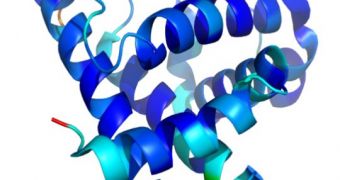When analyzing things at the nanoscale, every bit of extra resolution counts. This was made obvious by a new research, conducted at the US Department of Energy's (DOE) Brookhaven National Laboratory (BNL), when experts managed to get a tenth of a nanometer improvement in their studies of proteins. While this may seem insignificant at first, it may very well be the difference between seeing where atoms are located inside zinc transport proteins and understanding how they interact.
The new work does not only offer a better view of this specific protein, in terms of structure, but also suggests a mechanism that the tiny structure uses in order to sense and regulate zinc. Further knowledge of this could help scientists and healthcare experts devise new treatments for conditions such as seizures, diabetes, and, possibly, even Alzheimer's disease, in the future. Details of the BNL achievement can be found in the September 13th issue of the respected scientific journal Nature Structural & Molecular Biology, e! Science News reports.
“Our goal is to reveal atomic interactions in a protein structure to understand the chemistry that underlies the protein's biological function. With this structure, we can begin to understand the mechanism of zinc transport at a chemical level,” the leader of the new research, BNL biologist Dax Fu, explains. When applied to plant chloroplasts, the new viewing method could also yield more insight into how to produce biofuels from organic materials more efficiently.
“As illustrated by this study, even small improvements in X-ray diffraction resolution can greatly advance our mechanistic understanding of protein function,” Fu adds. X-ray crystallography equipment from the BNL's National Synchrotron Light Source (NSLS) was used for this investigation. There were, however, some things that could not be detected, the team reveals. “Exactly how the protein pushes the zinc ions through the membrane has yet to be determined,” Fu says.
Further research will be conducted over the next years, when more advanced light sources become available. The NSLS-II is scheduled to open in 2015, and it will be one of the brightest light sources in the world at the time. Experts estimate that it will be 10,000 times more luminous than the NSLS. With this instrument, the most intricate details of atomic interactions in proteins will reveal themselves to scientists, experts hope.

 14 DAY TRIAL //
14 DAY TRIAL //